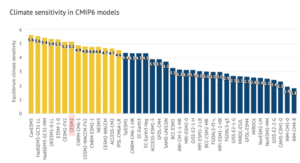by K. Richard, Dec 20, 2024 in NoTricksZone
The evidence that rising CO2 concentrations lead to inconsequential warming keeps piling up.
In a new study, seven Viennese researchers provide more evidence the CO2 absorption band is already saturated at today’s concentrations (over 400 ppm). Rising CO2 levels thus cannot drive significant global warming.
“Data from ground measurements indicate that the downward (backward) radiation of the atmosphere shows indeed full saturation of the IR CO2 bands and does not support noticeable additional Thermal Forcing (TF) by increasing CO2 in the lower atmosphere.”
“…we can expect full saturation already at current concentrations.”
As Table 2 from the study indicates, doubling CO2 from pre-industrial levels (280 to 560 ppm) increases global mean infrared absorption by just 1.1% (82.1% vs. 83.2%). This is an indicator of the decreasing effectiveness of CO2 as a warming agent as its concentration rises.
Indeed, a 400 to 800 ppm increase “shows no measurable increase in the IR absorption for the 15 μ-central peak,” and thus it can lead to just 0.5°C warming at most.
…


